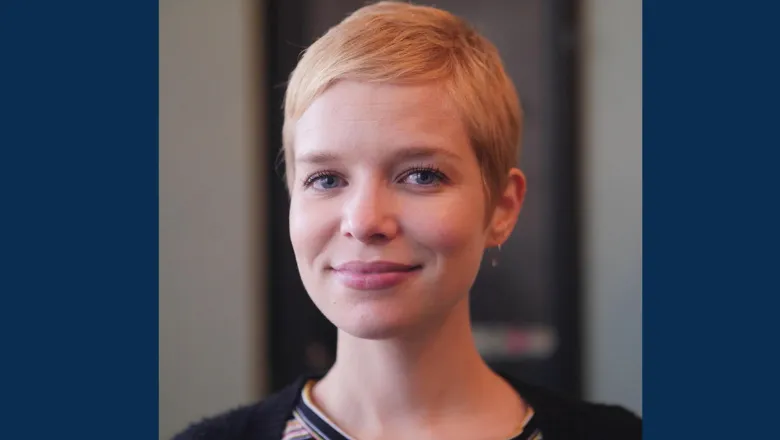10 April 2019
5 Minutes with Teresa Zulueta-Coarasa
Dr Teresa Zulueta-Coarasa is an EMBO Postdoctoral Research Fellow in Professor Jody Rosenblatt's Group in the Randall Centre for Cell & Molecular Biophysics. During her master’s studies, Teresa developed an algorithm to automatically classify different pulmonary emphysema types from CT scans and recently developed image analysis tools and combined experimental and computational techniques to explore the physical basis of embryonic wound repair. Her current research includes using bio-mechanics and quantitative image analysis to investigate how mechanical signals affect cancer cell spreading in vivo.

Briefly, tell me about your background and career up to this point at King’s?
I earned my M.Sc. in Biomedical Engineering at the University of Navarra in Spain and completed my Master’s Thesis under the supervision of Professor Raul San Jose Estepar at Brigham’s and Women’s Hospital, Harvard Medical School. During this time, I developed an algorithm to automatically classify different pulmonary emphysema types from CT scans. Afterwards, I moved to Canada to attend the University of Toronto, where I was awarded my PhD in Biomedical Engineering for work completed with Professor Rodrigo Fernandez-Gonzalez. I developed image analysis tools and combined experimental and computational techniques to explore the physical basis of embryonic wound repair, which has important implications for understanding embryonic development and disease.
Recently I have been awarded an EMBO long-term fellowship and a Marie Skłodowska-Curie Individual Fellowship to pursue postdoctoral work in the laboratory of Professor Jody Rosenblatt at King’s.
What research are you currently working on?
I am currently applying my skillset in biomechanics and quantitative image analysis to investigate how mechanical signals affect cancer cell spreading in vivo. In the lab, we can express commonly cancer-associated mutations in the zebrafish larva skin. The beauty of the zebrafish larvae is that they are transparent, which allows us to visualise the behaviour of these cancer cells in the whole organism. My colleague John has found that, in our system, cancer cells that were originally in the skin are able to invade inside the body and form distant masses. I am going to further investigate how this happens and if the mechanical environment inside the body has a role in helping these cells acquire malignant phenotypes.
What is a typical day like for you?
I usually start the day by replying emails, and then I would say that 50% of my day is bench work and 50% is computational work. Most of my experiments involve live imaging, so I spend quite a lot of time at the microscope. In parallel, I like analysing my experiments as I perform them, so I usually spend time deciding how I am going to quantify them, generating scripts for image analysis and then running the scripts and interpreting the results. Of course, sometimes I do more involved experiments that require me to work at the bench all day, or I need to catch up with my analysis and so spend the day working at the computer. That’s the great thing about science, every day is different!
Where is your research area heading in the next 5 years?
In the last few years, there has been an emergence of thinking about organisms as physical systems and, as a consequence, there has been a boom in studies investigating cellular mechanics. I hope that the increased appreciation for biophysical and image analysis methods in the study of cell biology will help us have a better understanding of the mechanisms that drive metastasis and cancer spreading in vivo.
What would you like members of our school to most know about you and your research area?
During my PhD, I was very lucky to be able to collaborate with several research groups that were doing very different things. I feel that this was very important for my growth as a scientist and I hope to be able to build similar collaborations here at King’s.
What is your favourite part of your current role?
My project is kind of uncharted territory for the lab, so I’m very excited about all the possibilities and open questions. Also, I love to work with people with such different scientific backgrounds as it helps me learn new things.
What do you do with your time outside of academia?
I moved to London very recently so, right now, I’m discovering the city little by little, by walking around different neighbourhoods. My favourite way to get to know a town is to wander aimlessly; you can find so many cool places off the beaten path! Also, for the first time ever, my husband and I have a little garden and we are working on it quite a lot these days. It’s very relaxing!
What advice would you give to your 18-year-old self?
Do not listen to the people that tell you that you cannot do something and be kind to yourself.
Who do you look up to (inside or outside of academia)?
I am very concerned about climate change, so lately I have been in awe of the young activists led by Greta Thunberg that are fighting for our future.
Any leaving remarks that you would like other members of our school to know about you?
Please come say hi. We are a new lab and we really want to get to know you all!
QUICK-FIRE:
Favourite Movie: Lost in translation.
Favourite Book: Dracula
Favourite TV Show: The (American) Office and Taskmaster.
Favourite Scientist: Ada Lovelace and Marie Curie
